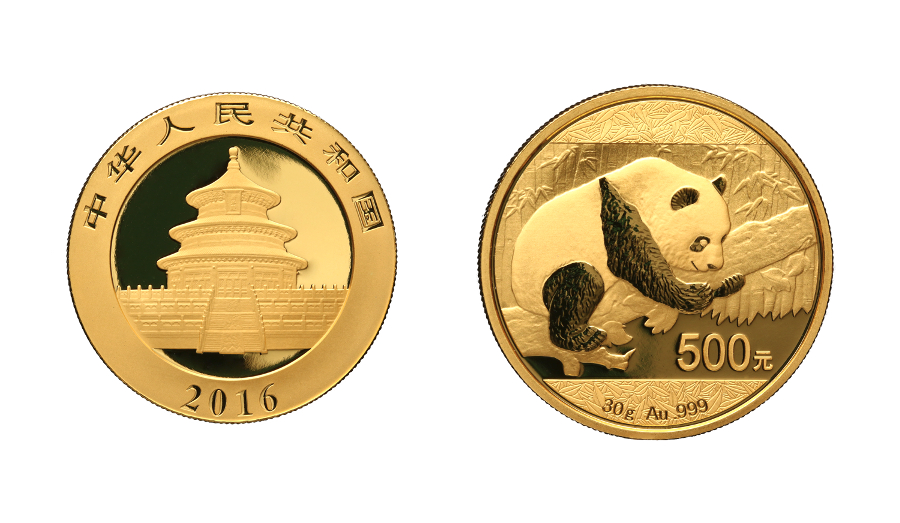The 1980s were golden for gold investors, with mints around the world seeking to capitalize on gold’s rising price and the re-opening of the US gold market in 1975 to stake their claim to investor demand. With the increased competition, gold investors were suddenly awash in a plethora of choices. And while old favorites such as the Austrian 100 Corona, the Krugerrand, and others still remain popular, newer coins have managed to gain popularity among investors too. Among those is the Chinese gold panda bullion coin.
First minted in 1982, the Chinese gold panda’s obverse features an image of the Temple of Heaven in Beijing. The reverse features images of pandas, with the design changing each year. That changing design makes the coins a favorite not only of investors but also of collectors, who look forward each year to a new design.
From 1982 to 2015, the coins were issued in standard troy weights of 1 ounce, ½ ounce, ¼ ounce, 1/10 ounce, and 1/20 ounce. Face values for those coins were 100 yuan, 50 yuan, 25 yuan, 10 yuan, and 5 yuan respectively from 1982-2000, and 500 yuan, 200 yuan, 100 yuan, 50 yuan, and 20 yuan from 2001 to 2015. In 2016 the coins began to be minted in gram weights, with coins now issued in 30 gram, 15 gram, 8 gram, 3 gram, and 1 gram weights. That can be a little confusing for investors who prefer to calculate their gold holdings in troy ounces rather than grams.
Like most other gold coins, premiums will increase as the coins get smaller. Expect to pay about a 2% premium for the 1-ounce and 30 gram coins, 4-5% for the 1/2-ounce coins, 8-10% for the 1/4-ounce coins, and 20-30% for the 1/10-ounce and 1/20-ounce coins.
Because they are minted from 99.9% pure gold, the Chinese gold panda coins are eligible for investment through a gold IRA or precious metals IRA. That allows investors the ability to invest in gold coins while still maintaining the same tax advantages as a traditional IRA. Investors can invest in gold with pre-tax dollars, defer taxation until they take a distribution, and roll over existing retirement assets into a gold IRA. So if you’re interested in taking advantage of those provisions and investing in unique coins whose designs change every year, you might want to take a look at the Chinese gold panda.
Coin Specifications
Purity
99.9% gold
Weight
1982-2015
- 100/500 yuan: 31.103 g
- 50/200 yuan: 15.5515 g
- 25/100 yuan: 7.7758 g
- 10/50 yuan: 3.1103 g
- 5/20 yuan: 1.5552 g
2016-present
- 500 yuan: 30 g
- 200 yuan: 15 g
- 100 yuan: 8 g
- 50 yuan: 3 g
- 20 yuan: 1 g
Gold Content
1982-2015
- 100/500 yuan: 1 troy oz.
- 50/200 yuan: ½ troy oz.
- 25/100 yuan: ¼ troy oz.
- 10/50 yuan: 1/10 troy oz.
- 5/20 yuan: 1/20 troy oz.
2016-present
- 500 yuan: 30 g
- 200 yuan: 15 g
- 100 yuan: 8 g
- 50 yuan: 3 g
- 20 yuan: 1 g
Diameter
1982-2015
- 100/500 yuan: 32.05 mm
- 50/200 yuan: 27.00 mm
- 25/100 yuan: 21.95 mm
- 10/50 yuan: 17.95 mm
- 5/20 yuan: 13.92 mm
2016-present
- 500 yuan: 32 mm
- 200 yuan: 27 mm
- 100 yuan: 22 mm
- 50 yuan: 18mm
- 20 yuan: 10 mm
Thickness
1982-2015
- 100/500 yuan: 2.70 mm
- 50/200 yuan: 1.85 mm
- 25/100 yuan: 1.53 mm
- 10/50 yuan: 1.05 mm
- 5/20 yuan: 0.83 mm
2016-present
- 500 yuan: 2.70 mm
- 200 yuan: 1.85 mm
- 100 yuan: 1.53 mm
- 50 yuan: 1.05 mm
- 20 yuan: 0.83 mm
Image: CoinInvest GmbH via Wikimedia
This article was originally posted on Red Tea News.





